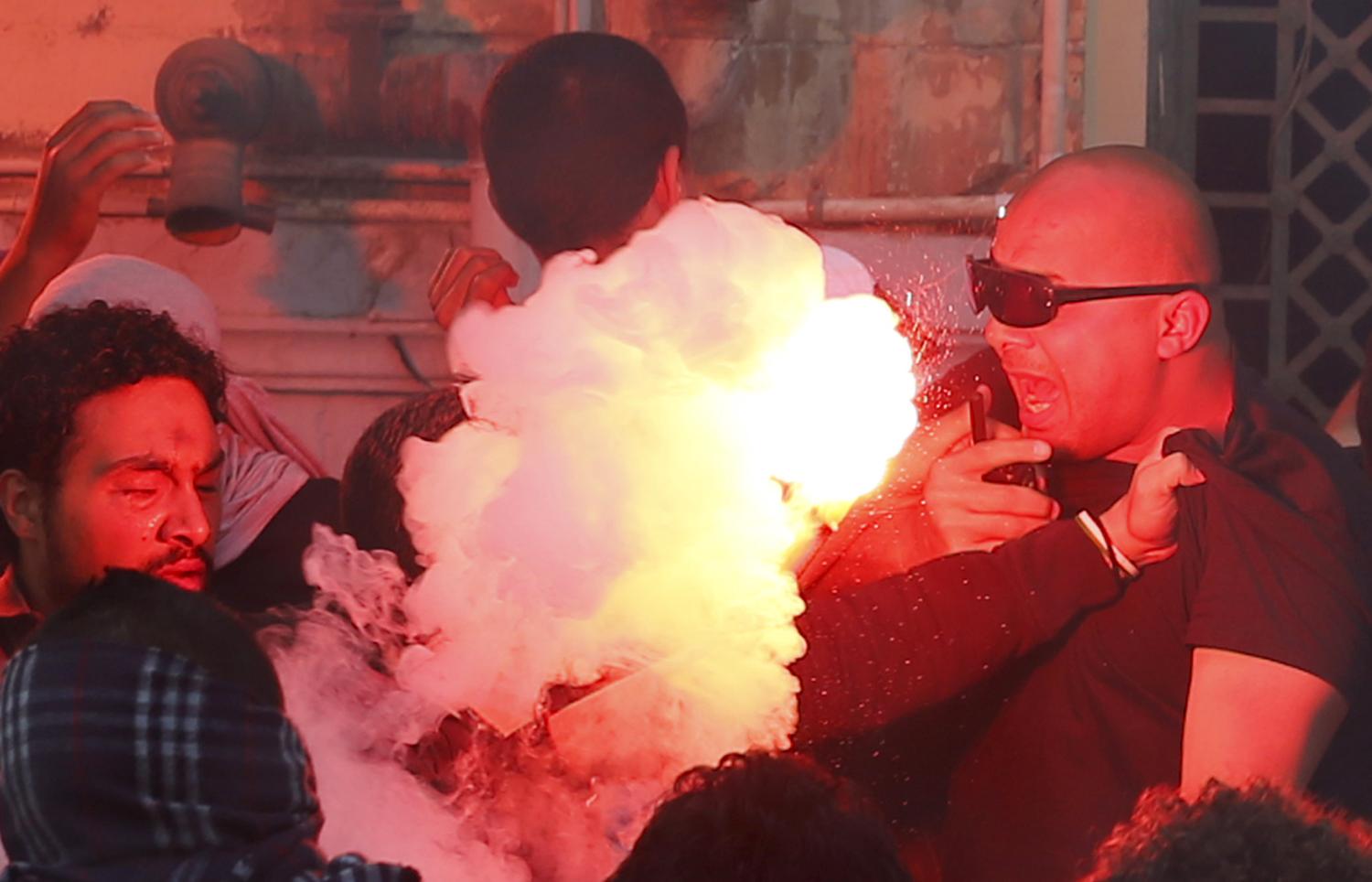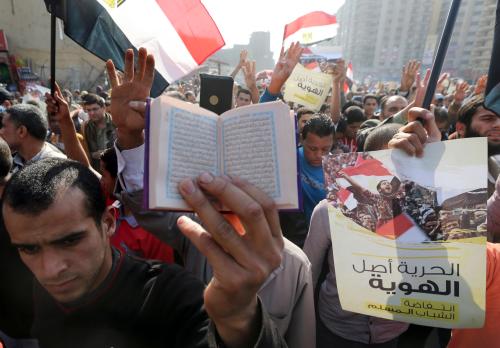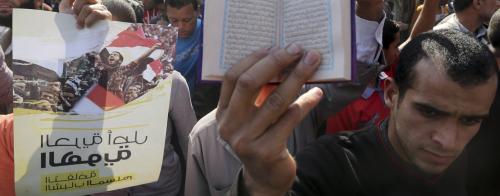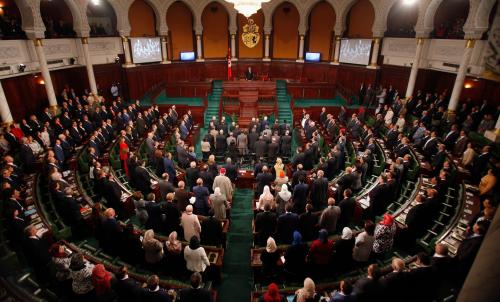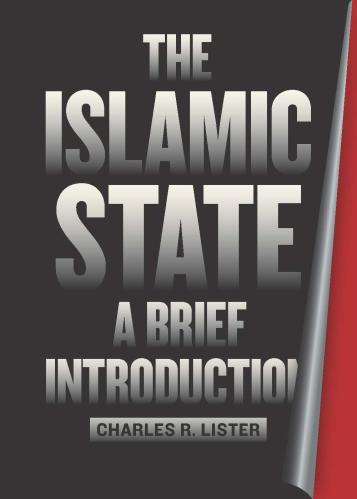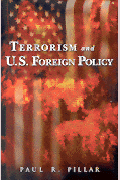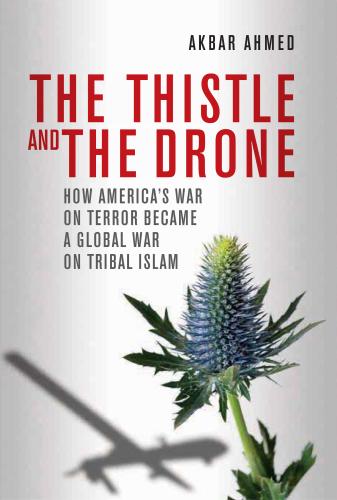The military coup of July 2013 forced the Muslim Brotherhood to retreat to a climate of secrecy after the group had spent just a year working openly and in power. The authorities soon designated it as a terrorist organization, and banned around 1,200 of the civil institutions affiliated with the group or its members, to say nothing of the thousands of people killed and imprisoned. The Brotherhood was left with no other option but to protest in a climate characterized by exclusion and McCarthyism.
This essay discusses the effect of this unprecedented security campaign on the group’s ideology and its internal decision-making processes. This is an important topic to explore especially after the arrest of the group’s most influential leaders, and the prevailing state of uncertainty in the region. Violence, whether from the state or from armed militias, has become the dominant political language in the nations that experienced Arab Spring revolutions, with the possible exception of Tunisia (which itself has not been spared from increasing terrorist threats). Even so, I argue here that the likelihood of the Muslim Brotherhood resorting to violence in Egypt is less then what many observers believe. Much of this has to do with the current structure of the organization, and the model of thought and culture that has governed it for decades. This, however, is not inconsistent with the increased possibilities that a not-insignificant segment of members and supporters will resort to responding to the state’s violence with violence, whether on an individual, decentralized level, or by joining more violent groups such as “Sinai Province” or “Al-Murabiteen,” or even by joining the ongoing wars in Syria and Iraq.
The social and the political: returning to the first founding
Since its formation, the Muslim Brotherhood has primarily been a social movement, whose program depends on affecting social change as a foundation and a condition for political change. Therefore, Hassan al-Banna was concerned with first changing and reforming the social order before changing the political order, as changing the latter was contingent upon reforming the former. As a result, attention was primarily directed to the “ummah” [the global Muslim community] rather than “the authority.”1
This is one of the fundamental issues that confronts any researcher or historian writing about Muslim Brotherhood. Certainly, Hassan al-Banna sought large-scale political change, and was not satisfied with religious preaching and fighting against moral deviations within society. However, political reform, from his point of view, was not possible without changing the conditions of society itself, as he considered the political system (the ruling authority) a natural result of the state of society. Therefore, when he founded the Muslim Brotherhood in 1928, his main focus was solely on societal conditions and he completely avoided any political participation. The first internal bylaws of the Brotherhood, issued in Ismailia in 1930, states that the group is not involved in politics. Article 2 states that “this group shall not become involved in political affairs, whatever they may be.” Article 15 emphasized non-engagement in political affairs during the group’s meetings. Even more notable is the fact that Article 42, which sets the mechanism for amending the bylaws, completely forbids changing some of the articles, including the aforementioned Article 2, which prohibits the group from engaging in political work.2
With these regulations in mind, the goals of the organization are limited to the social and moral sphere. This includes spreading Islamic teachings, combating illiteracy, raising awareness on healthcare (especially in the villages), fighting the scourges of society such as drugs and prostitution, and remedying economic crises through preaching and guidance. Accordingly, the group’s activities centered on opening schools, holding lectures, and establishing headquarters for the organization in the various provinces.
However, priorities changed. In the opening of the first issue of al-Natheer magazine in May 1938, Hassan al-Banna clearly stated “Until now, brothers, you have not opposed any party or organization, nor have you joined them… but today you will strongly oppose all of them, in power and outside of it, if they do not acquiesce and adopt the teachings of Islam as a model that they will abide by and work for…There shall be either loyalty or animosity.”3
Hassan al-Banna was not especially clear in defining his next steps, and, as a result, the reality of his vision – and the best ways to achieve it – remains contested. Banna mobilized the masses to build a strong social and religious base, and over the years, he began to mobilize this base politically. This manifested itself in a number of ways, such as forming groups within the military, judiciary and police, which were loyal to the Brotherhood. Another example includes creating the Special Military Apparatus in the 1940s, which was perceived as a possible threat to the political regime.
In Banna’s imagination, did the Brotherhood’s ultimate goal necessitate political rule after gaining a wide societal mandate? In other words, was building a wide social base merely a means to the end goal of gaining political power? This may not be as far-fetched as one might think, especially given that Hassan al-Banna described the “stages of da’wa [religious education and preaching]” as: first, defining the idea and spreading it; second, selecting supporters and members to form a strong base for the organization; and finally “implementation,” a nebulous term which has perplexed insiders and outsiders alike. Hassan al-Banna did not elaborate on what he meant by “implementation.” Confusion abounds since he firmly rejected political party work and was not enthusiastic about class revolutions built on favoring one class over the other. However, he also did not reject the idea of revolting against governments that did not respond to the aspirations of the people. He affirmed that if constructive criticism and advice to rulers did not lead to change, then other viable options range from the active repudiation of the ruling authority (khal’) to separating and disengaging from it (ib’ad).4
However, the group adopted Hassan al-Banna’s discourse of social change, rather than direct political change. This discourse stressed that building a broad social base which believed in Banna’s ideas was the only path to building a political regime that would implement them. The Brotherhood’s rejection of revolutionary change was further entrenched after its painful experience under Nasser. The group was always ready to offer political concessions in exchange for more freedom to practice its social and religious activities, believing this to be the investment needed to achieve any political change. Hassan al-Banna himself birthed this trend when he and sixteen others from the group withdrew their candidacies for the 1942 parliamentary elections in exchange for greater leeway in carrying out the group’s social and religious activities.
In 2004, the former Supreme Guide Mohammed Mahdi Akef announced that the group was embarking on a new phase under the banner of “Openness to Society.” Internally, this signaled a progression up the theoretical ladder of priorities set by Hassan al-Banna (the individual – the family – the society – the state – “mentorship” (ustadhiyya) of the world). This new phase was characterized by widespread competitive political participation and unprecedented engagement in the public sphere.
The limited emphasis on political activity inside the organization is reflected in the structure of its central technical committees. The committees are divided into the following: the Political Committee, the Professionals Committee, the Workers Committee, the Students Committee, the Sisters Committee, the Charity Committee, the Committee for Spreading the Islamic Dawah, and the Cubs Committee (for students who have not yet reached university). All of these committees, with the exception of the Political Committee, are concerned with directly communicating religious and moral messages to different segments of society. These committees did not adopt political messages except perhaps during the periods of electoral campaigning, which the group went through only a few times during the thirty years that preceded the January 2011 revolution. These periods were always viewed within the group as the exception rather than the rule.
Did this change after the revolution? Certainly. There is a growing feeling that it is futile to expect that broad societal change is necessary before the ruling regime can be changed. Social change is a continuous process that cannot be measured easily. In addition, the state’s centralized ideological apparatus has the ability to manipulate mass public opinion.5 In other words, the capability of any social organization to mobilize the masses remains limited in the face of a powerful state. The centralization of the modern state – particularly in authoritarian regimes – furthered its dominance of the public sphere, including in education, media and official religious institutions. The Brotherhood experienced this firsthand during President Morsi’s rule. The group found it difficult to compete with the official bureaucratic organs of the government. For instance, Egypt’s gargantuan state-owned media was able to influence the Brotherhood’s own constituency, despite having been exposed to the group’s political and religious messages for years.
Despite this, it’s important to highlight that the revolution inspired a renewed confidence in the viability of civil and nonviolent approaches to confronting authoritarian systems of control. Historically, emergent social and political organizations aiming to mobilize public opinion against the ruling regime would be easily squashed in their infancy.
But after the revolution, a growing number of Brotherhood members, particularly youth activists, became convinced that achieving “revolutionary” goals like regime change could not be achieved through the comparatively feeble means of “gradual reform” suggested by the movement’s founder. Banna was inspired by previous calls for Islamic reform that predate the modern state, when state-society relations were based on completely different power dynamics.
Going forward, the Brotherhood is unlikely to set aside societal reform to focus on capturing the state through political campaigning and other related activities. Rather, internal debates within the organization will lead to limiting the group’s direct participation in political activity. The Brotherhood is more likely to restore its fundamental role as a social and religious reform movement, as I discuss in the following section.
The “Primary Group”
Hassan al-Banna worked to promote the model of the “primary group,”6 a vanguard which would provide the emotional support needed to integrate people into social and public life. The term “primary group” was coined by Charles Horton Cooley (1920) to refer to a group characterized by intimate, face-to-face association and cooperation. This produces strong ties of loyalty and solidarity.7 This group, in the context of the Muslim Brotherhood, was to become a mediator between the individual and society. To maintain the nascent Brotherhood’s cohesiveness, Banna’s model emphasized the building and fostering of emotional and spiritual ties between members as much as it emphasized the role of social and economic ties.
Discussing the importance of spiritual bonds in the Brotherhood is beyond the scope of this essay. But it is important to highlight that Hassan al-Banna grew up among the ranks of the Sufi orders (specifically the Hasafi order). He gained insights on the importance of spiritual ties in strengthening the structure of a social organization. Later, Banna would develop this philosophy and place it within a more cohesive and holistic model. Through the system of usras, or “families” of five to ten members, he was able to strengthen the internal ties between different individuals in the organization. This is confirmed by Waheed Abdul Mageed, who argues that, while Banna’s Sufi tendencies were not apparent later in his life, they found new expression in the consciously-cultivated spiritual bonds built between members of the Brotherhood.8
The three pillars of the usra as outlined by Banna emphasize the fraternal connections between members: getting to know one other (ta’aruf), understanding one another (tafahum), and looking out for one another (takaful). For decades, and to this very day, the Brotherhood has featured teachings and practices concerned with deepening the spiritual connection between members (rabita), whether through cultural programs that focus on Islamic concepts such as “brotherhood,” “preferring others over the self,” “the love of God,” and so on. Another example is that of the daily “Bonding Litany” (wird al-rabita), a prayer recited daily by Brotherhood members. The word wird in Arabic, translated here as “litany,” refers to a set combination of supplications, specific selections from the Quran, or other selected religious passages. This litany is a fixed daily ritual in which the individual vows to pray for his brothers, and to remember them and the spiritual connection that binds them together, even if he does not know them by name.
Since its founding, the notion of “comprehensiveness” (shumuliya) has also been an essential feature of the Brotherhood. The group’s adoption of a comprehensive approach is reflected in its religious, educational, social, developmental, economic, and political activities. Hassan al-Banna’s envisioned Islam as a holistic system dealing with all aspects of life, one that leaves little room for modern notions of the secular. According to Banna, Islam’s comprehensive nature does not mean that every aspiring Islamic organization must cater to all spheres of life. Yet for his organization, Banna explicitly desired to structure it in a way that would reflect this comprehensiveness.
This particular aspiration of the Brotherhood has generated much analysis and speculation. It is unlikely that the organization will abandon its conviction that Islam is a comprehensive system. The Brotherhood views Islam’s rulings and teachings as relevant to both private and public life, as well as in the economic and political spheres. But does the Brotherhood as an organization have to be comprehensive? Modern life has become exceedingly complex. The increased specialization of knowledge has only accelerated with the advent of the modern state and its ability to mobilize heretofore unprecedented power and resources. In short, is it better to be a jack-of-all-trades, yet a master of none?
The Brotherhood’s brief experience of being in power and its subsequent removal by military coup has served to strengthen the idea of separating the Brotherhood’s role as a social institution from its role as a political force. The two functions now operate in tension and even opposition, and the Brotherhood’s traditional practice of grouping them together has only served to weaken both. The notion of Islam as “comprehensive” can still be maintained as an ideal, while organizationally, one may choose to focus on certain aspects of this comprehensiveness (such as social, religious, or cultural programming) and eschew others (such as forming a political party or directly participating in elections). In this way, the group would be able to effectively leverage a strong and principled constituency to influence the political sphere. In hindsight, it appears that the Brotherhood’s direct participation in competitive politics has done substantial damage to decades of social and religious institution building.
Despite its problematic aspects, focusing on Islam’s “comprehensiveness” has made the Brotherhood’s activities quite diverse, providing it a number of ways to connect with varied sectors of society and helping it to maintain an impressive membership base. It was this myriad of factors acting in concert that carried the Brotherhood to power in the 2011 elections, and not its reputation as a trustworthy and experienced political party, as is normally the case. Despite criticisms within the Brotherhood of its political performance, the diversity of its areas of focus and its intertwining of social, religious and spiritual activities continue to motivate members to work toward the realization of Hassan al-Banna’s vision.
The state and the organization: the struggle over the Brotherhood’s social base
With the Muslim Brotherhood’s second phase (from the mid-1970s until around 1987), the leadership introduced several core features, such as increased centralization and organizational interdependence (to which a greater atmosphere of secrecy was added, contrary to Hassan al-Banna’s organization, which worked as an official, known group). They also ratcheted up the group’s activities in the political and economic spheres. Moreover, they set to work on the construction of a broad network of social institutions, including schools, service projects, charitable groups, and hospitals.
These changes produced a complex institutional structure that prioritized more direct engagement with society and lent itself to a heightened focus on a more “comprehensive” organizational model as described above. This produced both a strong interconnected organizational structure, as well as a wide social base that could be relied upon to embrace the group during its intermittent conflict with the state in the years of Mubarak’s rule.
The 2013 coup sought to eliminate these two sources of the group’s power and resilience. Events first kicked off with an aggressive anti-Brotherhood media campaign, designed to impair the performance of President Morsi and his government, isolate the Brotherhood from its social base, and remove any excuse the general populace may have had to maintain sympathies with the organization. By the end of June 2013, the state succeeded in “factionalizing the Brotherhood,” by portraying them as fifth-columnists separate from the rest of the population with self-serving goals. The message was clear, that the Brotherhood doesn’t have Egypt’s best interests at heart, only its own. This was followed by a rapacious security campaign that continues to the present day. Many have fled or otherwise gone into hiding, including most members of the Guidance Office9, around half of the members of the general Shura Council, those in charge of the Brotherhood’s administrative offices in the provinces, and most leaders of the Brotherhood’s Freedom and Justice Party.
The targeting of the Brotherhood’s social base required eliminating the group’s civil and economic organizations. The state officially announced that the assets of 1,370 individuals had been confiscated, along with the assets of 81 companies, including 19 currency-exchange companies. A total of 1,125 associations, 105 schools, and 43 hospitals were confiscated, in addition to the Brotherhood’s medical association, which has 27 branches, as well as the Rabia Adawiya Association, which has two branches.10
A widespread campaign of arrests, resulting in the apprehension of over 40,000 prisoners, occurred alongside a vengeful security crackdown, which included acts of torture, public killings, and sexual assault. All these actions have made violent action easier to countenance to Brotherhood members. Violence found easier justification in a regional context beset by instability, civil war, and the success of fanatical Islamist groups such as the Islamic State organization, or ISIS.
A climate of violence and chaos
The armed Islamist group Ansar Bayt al-Maqdis (ABM) strengthened its influence in the Sinai after the military coup. In its calculus, the collapse of Islamists’ gamble on democracy proved the impossibility of change through standard political mechanisms. In short, it was a victory for those advocating force as the only effective route to change. This small group in the Sinai exploited events to press the need for directly confronting the state, and was able to attract members from outside the Sinai. The rise of ISIS and the subsequent military campaign in the Sinai against ABM led to additional popular support for the group, which would go on to formally affiliate itself with the Islamic State, rebranding itself as ISIS’s “Sinai Province.” This compelled Hisham Ashmawy, a prominent ABM leader and former officer in the elite Egyptian Special Operations “Thunderbolt” Force, to break off and form the group Al-Murabiteen.11Ashmawy’s actions opened a wider arena for attracting members from Cairo and the delta provinces.12
At the same that Sinai jihadists were escalating their activities and seeking to expand their reach into the heart of the country, Egypt’s largest civic Islamic organization was being crushed. The Brotherhood was cast out from all of the “pillars of democracy” – the parliament, the presidency, and the constitution. In this context — and after the greatest instance of mass killings in Egypt’s modern history — it is not a surprise that armed groups sought to capitalize on these events and use them as a pretext for violent action. Pointing to the Brotherhood’s aborted reign as primary evidence, armed groups argued that democracy would never permit an Islamist victory, even if fairly earned. It then became simple to paint the picture of a supposed “war on Islam” that could appeal to disillusioned individuals.
There are a number of cases where members of or those close to the Brotherhood and members of those revolutionary Salafi groups that participated in political life after the January 25 revolution chose to take up arms within the ranks of ISIS’s Sinai Province. A small number even travelled to fight in Syria or Iraq, either to join ISIS or Syrian armed opposition groups. Their letters and other statements reveal the degree of hostility towards the Brotherhood’s peaceful, gradualist program and its disgraceful “surrender” to the state’s crimes at the Rabaa sit-in as well as cases of rape of female prisoners. Sinai Province’s media discourse churned out messages directly aimed at young Islamists, particularly members of the Brotherhood, lambasting the ineffectiveness of nonviolence and democracy, and advocating jihad and armed resistance to the state as the only viable path forward.13
Is violence the Brotherhood’s inevitable choice?
Harvard University’s Steven Brooke, one of the contributing authors to Brookings’ Rethinking Political Islam initiative, argues that the restriction of the Brotherhood’s social activities and the shuttering of the group’s social institutions has left the organization with only one choice: holding demonstrations.14 He argues moreover that demonstrations will eventually hit a wall and fail to achieve the Brotherhood’s goals, pushing the group towards violence. Additionally, the destruction of the group’s social service infrastructure strengthens the attraction of other, more violent models, such as those of ISIS or al-Qaeda in Yemen. Despite the strength of this hypothesis (particularly its compelling claim that violent approaches may find supporters among broad segments of society), there are a number of factors that limit the applicability of Brooke’s argument to today’s Muslim Brotherhood.
First, one’s motivation for joining the Brotherhood cannot be reduced to a desire to be involved in the social sphere. There are many complex motivations that drive an individual’s desire to be a member of the Brotherhood. Eliminating one sphere or aspect of the group’s activities does not necessarily mean that members will inevitably look for alternatives, whether a violent approach that rejects the state or one accepting of state authority. A field study that I conducted from October to December 2013 revealed that, for many members of the Brotherhood, the group’s top priority was not social work. Rather, it involved providing the support and care to the families of the victims of the coup and those imprisoned, as well continuing protests against the coup.15
In the current environment, it will be difficult to pursue social activities for a number of reasons. First, Brotherhood members and cadres are subject to far-reaching surveillance by state security, making it almost impossible to carry out any activities unnoticed. Second, the group’s social institutions have been almost entirely confiscated by the regime. Third, due to the large number of people who have been arrested, disappeared, or made to flee the country, it has become necessary to focus internal efforts of the group on supporting those bearing the brunt of repression inside of Egypt, as well as on activities aimed at delegitimizing the coup. Though there has been no decision to suspend the group’s religious or social activities, they are simply not the priority. Such activities have instead been left to individuals and smaller, more local units to decide what headway can realistically be made in these areas.
Second, there is no doubt that the line between peaceful revolutionary protest and the use of more violent means is sometimes “blurry,” as described by Steven Brooke. However, over two years have passed since the Rabaa massacre, and the major trend within the Brotherhood (and the anti-coup movement in general) remains committed to peaceful political action. All groups that have tried to adopt some form of violence continue to be marginal with limited appeal. The adoption of violence clearly contradicts the reigning cultural model within the Brotherhood. It is of course true that, theoretically, any dominant culture can undergo change, but this requires a conducive environment for doing so. For example, there were ample opportunities in the 1960s to adapt the group’s culture in response to Nasserist oppression, but the Brotherhood leadership was able to successfully challenge those pressures and maintain the group’s position on violence and takfir (accusing a fellow Muslim of apostasy).16The current debate inside the group reflects similar questions. When rumors began to circulate that some leaders were moving towards violent options in their opposition to the coup, this was met with broad rejection within the group, both inside and outside the country. Later, it became clear that the question of violence is not, in fact, the central dispute. Rather, disputes appear more related to a clash between an older, traditional leadership unwilling to give up their positions and a new leadership that came to prominence after the coup, which rejects the “old” administrative model and seeks to implement leadership changes. Change in the organization’s culture as a result of the military coup and its aftermath is possible, but, at the time of writing, the essential requirements for such a shift are not present. One such requirement is the emergence of legitimate and charismatic leadership with a clear strategy and vision to manage internal conflicts within the organization.
A legitimate, charismatic leadership is necessary to effect radical change of this kind, not only on an intellectual level but also on a practical one. In a centralized, conservative organization like the Brotherhood, reshaping the organization’s structure and hierarchy of is a considerable challenge. Decentralization within the Brotherhood has been limited to organizational and administrative activities and the allocation of resources. Political decision-making, or the crafting of a vision for handling internal conflict, remains extremely centralized. One reason for the recent exacerbation of internal disagreements is the fact that of those who remain from the old Guidance Office (three individuals inside Egypt), two of them are insistent that major decisions must remain solely the purview of the acting General Guide Mahmoud Ezzat — a position rejected by a number of recently elected provincial leaders. Likewise, the Brotherhood’s Shura Council still maintains a palpable level of administrative control, as around half of its members are still active, whether from inside or outside Egypt.
The Brotherhood has demonstrated a considerable level of flexibility in adopting different methods under difficult circumstances to achieve its top priorities (protesting the coup and taking care of families of victims and the imprisoned). However, major political decisions, the setting of overarching organizational strategies, and the management of financial resources within the group remains highly centralized. It should be noted that many older leaders who have not been arrested have been willing to give substantial roles to younger members. However, these roles are confined to mid-level administrative positions and seats on technical committees. In effect, the Brotherhood’s centralized character remains, making it extremely difficult to effect major changes to its intellectual trajectory.
Third, other models for social service provision do not necessarily represent alternatives to the Brotherhood, as the group adopts a very specific approach to social work. The Brotherhood in Egypt considers social activities to be one of its primary roles and has historically carried them out transparently and under the authority and laws of the government. On the one hand, the Brotherhood, from an Islamic perspective, sees social work as a necessity in and of itself. Social work builds solidarity with local communities, and is connected to Islamic teachings on showing kindness to the poor and the downtrodden. Yet on the other hand, the Brotherhood is well aware that its social activities help it achieve a wider reach within the country and strengthens its social base. In contrast, armed Islamist groups are not motivated to carry out social activities in cooperation with the state, since their goal is to bring about the state’s demise. As a result, these groups do not undertake social work to win over constituents. Rather, they enter into such projects as a “ruling authority” that seeks to present a model for “Islamic rule,” which comes about after taking control of certain areas or when the state’s hold on these areas weakens. This is the current situation in the Sinai, parts of Yemen, and in the territory controlled by the Islamic State. However, where the state is clearly present, such groups have little interest in the provision of social services, as the elimination of the state through armed action takes priority.
The difference between these two models is fundamental. The Brotherhood, like other Islamic organizations such as al-Jam’iyya al-Shar’iyya and al-Jami’yya Ansar al-Sunna, provides social and charitable services for goals primarily related to Islamic values, which encourages caring for the poor, the weak, and the hungry. Additionally, the Brotherhood’s social and charitable activities have elicited increased popular support for the group’s political activities. This “model” carries out social services through official institutions subject to the law and operates under the authority of the state. The other carries out social services only to further the direct replacement of an absent or failed state with “Islamic rule.”
Of course, one could argue that the Brotherhood is, in a similar but less confrontational way, trying to present an attractive picture of its own vision for Islamic rule. However, the alternative it seeks to establish is a new political regime with different ruling elite, but emerging from the extant structures of the current state. In contrast, armed groups do not recognize the legitimacy of the state at all, and therefore do not concern themselves with social activities unless they are able to replace the state’s authority with their own. Only then would these armed groups — acting as the ruling power — exert their authority in all areas of governance, including social welfare. For example, ISIS’s Sinai Province does not provide social welfare in Cairo or in the city of Arish in Sinai, simply because these areas are not subject to its rule. It only provides a network of social welfare in the limited areas where it has strengthened its influence, or where the state’s authority is practically absent.
This does not rule out the possibility that the harshness of the political climate in Egypt may compel more individuals or unorganized groups to embrace violence. Armed groups may exploit the current environment to attract new members from beyond the Sinai, into the Nile valley and delta. However, as mentioned earlier, this expansion would not be based around the goal of providing social services. Rather, these armed groups’ top priorities are directly political and related to rejecting the current regime, and are powered by a belief in the impossibility of challenging it through peaceful means.
An uncertain future
The number and size of Brotherhood-linked demonstrations has greatly decreased over the past year for various reasons, including the violent security response to demonstrations, widespread arrests, and mass prosecutions by kangaroo courts. This has led tens of thousands of people to become either prisoners or outlaws forced to flee their homes, or even Egypt altogether. Likewise, the long-term continuation of protests requires a clear political vision, especially since the cost of participating in a protest could be death or years of imprisonment. Generic slogans and platitudes, however enthusiastic, will not do the trick.
The Brotherhood has yet to offer an alternative strategy to protesting and mobilizing opinion against the regime. Many in the group wager that the revolutionary moment has not passed, as the factors which inspired the revolution have yet to be addressed (poverty, unemployment, a lack of social justice, oppression by the security forces, smaller numbers, can still encourage others and help them maintain a mindset of protest within society until a new spark takes hold, snapping the spell of fear and frustration that has settled over the 2011 revolution’s supporters.
This theory is plausible, since the revolution’s initial impetus did not come from the Brotherhood, and was driven instead by years of built-up grievances in the population at large. However, reproducing such a mobilization in the face of the security force’s unprecedented repression will prove difficult. First, it requires building alliances based around broad demands, slogans, and programs that go beyond the tired dichotomies of the Brotherhood versus the Egyptian military, or a legitimately elected government versus a regime that came to power though a coup. In other words, the animating premise of the Brotherhood’s continuing protests and demonstrations is unlikely to appeal to wider audiences or recreate the conditions of the January 2011 revolution. As long as the Brotherhood’s political imagination is unable to overcome the mindset of “coup versus legitimacy” and develop an alternative political discourse that meets the demands of the disaffected social segments that ignited the January revolution, then the Brotherhood itself may be an obstacle in its efforts to build a new culture of protest. Such attitudes will hinder attempts to build wider political alliances between different, non-Brotherhood forces that also reject the military coup and Sissi’s rule.
Likewise, the group has not been able to adopt a clear plan, nor does it have clear answers regarding the possibility of coexisting with the current Egyptian state. The Sissi regime has taken a hostile position towards the Brotherhood through every means available to it, from the police, to the judiciary and the bureaucracy. If coexistence is not possible, does the group have recourse to any alternative scenario? Does the group truly seek, through its anti-coup protest activities, to exert pressure with the end goal of reaching a sort of modus vivendi? What would be the limits of such a settlement, and what are the concessions that the group can give without affecting its internal cohesion?
The current internal conflict within the Brotherhood mainly revolves around phrases such as “leadership change,” “institutionalization,” “amending the bylaws,” and “rejecting individualism,” but more conceptual and foundational questions and discussions over the group’s long-term vision remain absent from the debate. Some hypothesize that leadership change – if it occurs – is what will lead to the beginning of an internal discussion on these issues, as a new leadership would be more keen on reversing the current state of intellectual stagnation.
In any case, attempting to categorize the different trends within the Brotherhood by age or generation will be of little use. Though it may not seem immediately obvious, particular ideas do not remain the single purview of a specific age group. Different points of view find supporters among all age groups and at all organizational levels.
As always, there are those who adopt a radical vision of the current struggle, considering it to be a zero-sum conflict in which there can be no compromise. There are also those who are more willing to offer concessions with the aim coming to a sort of deal, which would redraw the relationship between the Brotherhood and the state. However, there is unanimous agreement within the Brotherhood that it is impossible to achieve any meaningful progress as long as Sissi remains in power. It is very unlikely — at least in my opinion — that this basic fact will change.
In my view, the coup and the unexpected repression that followed it, produced a change in the nature of the conflict at hand and complicated opportunities for compromise with the regime. The conflict has shifted from a political conflict between the Brotherhood as an opposition group and the ruling regime into a conflict between the Brotherhood and the idea of the Egyptian state itself. This “transition” occurred after the involvement of the state’s various apparatuses — such as the police, the military, the judiciary, and the bureaucracy — which had not been directly involved in the conflict with the Brotherhood since its re-establishment in the 1970s. Additionally, for the first time in its history, even the Egyptian Coptic Church has become directly involved in the state’s war on the Brotherhood and the Islamists. This has made church leaders, in the view of many, abettors to the killings and ongoing repression perpetrated by the authorities after the coup.
These complications require a comprehensive settlement, and not a token one. Likewise, they necessitate painful concessions and defined commitments. At this point, there is no justification or capability for either side to do these things.
Conclusion
Why hasn’t the Muslim Brotherhood in Egypt resorted to violence? Examining this question can lead to a better understanding of the consequences of the ongoing unprecedented security crackdown. This paper has used a socio-cultural approach that acknowledges the complicated relationship between individual members of the Brotherhood and the character of the organization as a whole. It also relied on the definition of the Brotherhood and its various roles, as understood by its members. The group fulfills different roles and carries out diverse activities to meet the needs and interests of its members. This is what gives the group the ability to maintain a portion of its internal work even if its external activities directed toward society are suspended for the time being.
This is not to say that the Brotherhood will be able to contain the anger of all its supporters, or even that it is the best model available for those Islamists who reject the military coup. Armed groups are still very much able to capitalize upon this delicate moment. The military coup affected the Brotherhood in ways that could substantially change the face of the group in the coming years. This could open the door for a redefinition of the nature of its political, social, and religious role.
Can the Brotherhood coexist with the current state, regardless of whether Sissi stays or goes? Answering this question is the Brotherhood’s central challenge. Until now, the group has not formed a clear political vision. Nor does it have the tools to remove the military from its political calculus. Therefore, the group must work with other forces that reject the policies of the current regime. Such an alliance can form a broad national front whose goals and programs are based on the priorities of the revolution at large. This national front could also delineate pragmatic plans to coexist with the political and economic influence of the military for the foreseeable future.
Some Brotherhood members have grappled with these questions and presented possible visions, but the group is yet to hold an internal dialogue to develop and adopt a unified stance. Likewise, military leaders have not shown any inclination to reach a settlement with the Brotherhood, which could end to their reliance on continuous levels of repression. This makes it likely that the status quo will persist, with all its tragic consequences.
-
Footnotes
- Rafiq Habib, “A Vision for the Political Future of the Muslim Brotherhood,” in The Crisis of the Muslim Brotherhood ed. Amr El-Shobaki. (Cairo: Al-Ahram Center for Political and Strategic Studies, 2009), 27-28.
- “The First Law of the Muslim Brotherhood in Ismailia,” Ikhwan Wiki: The Official Encyclopedia for the History of the Muslim Brotherhood. http://goo.gl/Dla0Oj.
- Hassan al-Banna, Al-Natheer Magazine, no. 1, 30 May 1938. http://www.ikhwanwiki.com/index.php?title=%D8%A7%D9%84%D8%B9%D8%AF%D8%AF_1_%D9%85%D9%86_%D9%85%D8%AC%D9%84%D8%A9_%D8%A7%D9%84%D9%86%D8%B0%D9%8A%D8%B1.
- Hassan al-Banna, “Letter of Teachings,” The Compiled Letters of Imam Hassan al-Banna.
- For more information, see Louis Althusser. “Ideology and Ideological State Apparatuses,” Lenin and Philosophy and Other Essays, Monthly Review Press, 1971.
- Henri Thery. Les Groupes Sociaux, Forces Vives?, trans. Rushdi Kamel Saleh (Cairo: The General Authority for Cultural Palaces, 2013), 46-52.
- Henry L. Tischler, Introduction to Sociology, (Belmont, CA: Wadsworth Publishing, 2007).
- Waheed Abdul Mageed. The Muslim Brotherhood Between History and Future: How was it and how is it now?, (Cairo: Al-Ahram for Publishing, Translation, and Distribution, 2010).
- 12 members of the Guidance office were arrested (among them the Mohammed Badie and his most important deputy Khairat El-Shater). Currently there are only three members present inside Egypt, and they are in hiding and on the run. The guide’s deputy Gomaa Amin Aziz died on January 24, 2015 in London. The Secretary General of the group, Dr. Mahmoud Hussein, is in Turkey.
- The committee formed by the government announced the confiscation of the Muslim Brotherhood’s assets. These are the final numbers, as of January 24, 2016. http://goo.gl/pndDW5.
- “A Former Officer in the Egyptian Army Calls for Jihad Against Sissi,” The New Khalij, 22 July 2015. http://www.thenewkhalij.net/node/17534.
- Mokhtar Awad and Samuel Tadros, “Baya Remorse: Wilayat-Sinai and the Nile Valley,” Combating Terrorism Center, August 2015. https://www.ctc.usma.edu/posts/baya-remorse-wilayat-sinai-and-the-nile-valley.
-
“Egypt’s Executions: A Green Light for ISIS Recruitment of the Muslim Brotherhood’s Young Men,” Al-Monitor, 24 June 2015. http://www.al-monitor.com/pulse/ar/originals/2015/06/egypt-sinai-muslim-brotherhood-terrorism-death-sentences.html.
See also: “Wilayat Sinai Sends the Second Round of ‘Sawlat Al-Ansar’ and Promises to “Butcher” Sissi,” The New Khalij, 3 March 2015. http://www.thenewkhalij.net/node/14135. - Steven Brooke, “The Muslim Brotherhood’s Social Outreach after the Egyptian Coup,” Brookings Institution, August 2015. https://www.brookings.edu/wp-content/uploads/2016/07/Egypt_Brooke-FINALE.pdf.
- I conducted this study in coordination with the Egyptian researcher Ahmed Zaghloul. The main conclusion I reached during the interviews is that members are convinced that the organization’s main responsibility is, first, working to reject and confront the military coup, and continuing activities that express this rejection; and, second, providing the necessary support to the families of those arrested and killed. In light of events, the majority felt that this is what demanded the Brotherhood’s attention, not the group’s return to religious and social. Likewise, there wasn’t a great fear of the group getting swept into the perpetration of violence. Many of the members expected that some individuals would turn to violence, but that the Brotherhood in general, given its structure and its political and religious choices over the decades, would not alter its main strategy built on peaceful civil activities and political opposition.
- See Hassan al-Hudaybi, “Preachers Not Judges.” http://www.ikhwanwiki.com/index.php?title=%D8%AF%D8%B9%D8%A7%D8%A9_%D9%84%D8%A7_%D9%82%D8%B6%D8%A7%D8%A9.
See also: “Wilayat Sinai Sends the Second Round of ‘Sawlat Al-Ansar’ and Promises to “Butcher” Sissi,” The New Khalij, 3 March 2015. http://www.thenewkhalij.net/node/14135.
